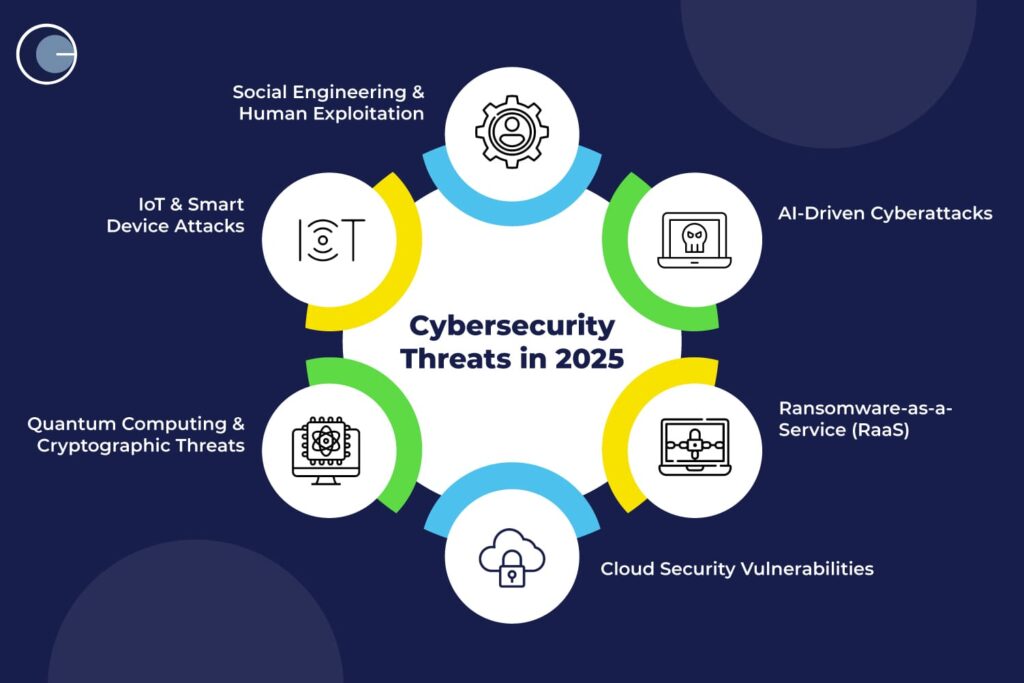Cybersecurity threats are becoming more sophisticated by the day. As businesses increasingly adopt cloud technologies, artificial intelligence (AI), and the Internet of Things (IoT), they also expose themselves to new and complex cyber risks. In 2025, organizations must stay vigilant to protect their data, systems, and customers from evolving threats.
In this blog, we’ll explore the most pressing cybersecurity threats in 2025 and provide insights into how businesses can safeguard themselves.

1. AI-Driven Cyberattacks
Artificial intelligence is revolutionizing business operations, but it is also empowering cybercriminals. In 2025, AI-driven cyberattacks are expected to become more prevalent, making it easier for hackers to bypass traditional security defenses.
How AI is Enhancing Cyber Threats:
- Automated Phishing Attacks – AI can generate highly convincing phishing emails that mimic human communication, increasing the likelihood of successful attacks.
- Deepfake Technology – Cybercriminals can use AI-powered deepfakes to impersonate executives or employees, tricking organizations into transferring funds or sharing sensitive data.
- Adaptive Malware – AI can create self-learning malware that adapts to evade detection by cybersecurity tools.
How to Mitigate AI-Driven Attacks:
- Implement AI-driven cybersecurity solutions to detect anomalies.
- Train employees to recognize phishing and deepfake scams.
- Use multi-factor authentication (MFA) to verify identities.
2. Ransomware-as-a-Service (RaaS)
Ransomware remains a major concern, as in 2025, cybercriminals are offering Ransomware-as-a-Service (RaaS), making it easier for attackers with minimal technical skills to launch devastating ransomware campaigns.
Why Ransomware is More Dangerous in 2025:
- Supply Chain Attacks – Attackers target third-party vendors to compromise multiple organizations at once.
- Double and Triple Extortion – Hackers not only encrypt files but also threaten to leak sensitive data or attack customers if ransom demands aren’t met.
- Faster Encryption Algorithms – Advanced encryption makes it harder for victims to recover files without paying a ransom.
How to Protect Against RaaS:
- Maintain regular offline backups to restore critical data.
- Deploy endpoint detection and response (EDR) solutions.
- Conduct cybersecurity awareness training to prevent employees from falling victim to phishing attempts.
3. Cloud Security Vulnerabilities
As businesses shift more workloads to the cloud, attackers are targeting misconfigured cloud environments, unsecured APIs, and weak authentication mechanisms.
Top Cloud Security Risks in 2025:
- Data Breaches – Poorly configured cloud storage solutions can expose sensitive customer and company data.
- Insider Threats – Employees or contractors with access to cloud platforms may inadvertently or maliciously leak data.
- API Exploits – Attackers can manipulate weak API security to gain unauthorized access to cloud-based applications.
Best Practices for Cloud Security:
- Enforce zero-trust architecture to limit access based on identity verification.
- Regularly audit cloud configurations to detect security gaps.
- Implement cloud security posture management (CSPM) tools to monitor compliance.
4. Quantum Computing and Cryptographic Threats
While quantum computing holds immense potential, it also poses a significant cybersecurity risk. In 2025, quantum computers are inching closer to breaking traditional encryption methods, putting sensitive data at risk.
How Quantum Computing Threatens Cybersecurity:
- Traditional RSA and ECC encryption algorithms may become obsolete.
- Encrypted financial transactions, medical records, and classified government data could be exposed.
- Attackers engaging in “harvest now, decrypt later” strategies may collect encrypted data now and decrypt it once quantum computers become powerful enough.
Preparing for Post-Quantum Security:
- Start migrating to quantum-resistant encryption methods.
- Monitor advancements in post-quantum cryptography and upgrade security frameworks accordingly.
- Use hybrid cryptographic approaches to safeguard sensitive data.
5. IoT and Smart Device Attacks
The rapid expansion of Internet of Things (IoT) devices in businesses and homes is creating new attack surfaces for cybercriminals. Unsecured smart devices provide entry points for attackers to compromise entire networks.
Common IoT Security Risks:
- Botnet Attacks – Hackers compromise large networks of IoT devices to launch distributed denial-of-service (DDoS) attacks.
- Default Password Exploits – Many IoT devices come with weak factory-set passwords, making them easy targets.
- Supply Chain Vulnerabilities – Malware can be embedded in IoT devices before they even reach consumers.
How to Secure IoT Devices:
- Change default credentials and use strong, unique passwords for all devices.
- Keep IoT firmware updated with the latest security patches.
- Segment IoT devices on a separate network to prevent lateral attacks.
6. Social Engineering and Human Exploitation
Even with advanced cybersecurity tools, human error remains one of the biggest vulnerabilities in 2025. Cybercriminals use sophisticated social engineering tactics to manipulate employees into divulging confidential information.
Types of Social Engineering Attacks:
- Business Email Compromise (BEC) – Attackers impersonate executives to request fraudulent wire transfers.
- Vishing (Voice Phishing) – Scammers use AI-generated voices to deceive employees over the phone.
- Quishing (QR Code Phishing) – Malicious QR codes trick users into visiting fraudulent websites.
How to Combat Social Engineering Attacks:
- Conduct regular cybersecurity awareness training for employees.
- Use email authentication protocols (DMARC, SPF, DKIM) to prevent spoofing.
- Encourage employees to verify suspicious requests via a second communication channel (e.g., phone calls).
How Charter Global Helps Businesses Stay Secure in 2025
The cybersecurity landscape in 2025 presents a range of complex threats, but businesses can stay ahead by partnering with experienced cybersecurity experts.
Charter Global offers a comprehensive suite of cybersecurity solutions to protect businesses against evolving threats:
- Cybersecurity Assessment & Risk Management – Identify vulnerabilities and implement risk mitigation strategies.
- Cloud Security & Compliance – Secure your cloud infrastructure with best-in-class security practices.
- DevSecOps & Secure Software Development – Integrate security into every stage of the development lifecycle.
- Threat Detection & Incident Response – Monitor, detect, and respond to cyber threats in real time.
- Managed Security Services – Get 24/7 security monitoring and support to safeguard your business.
Don’t wait for a cyberattack to disrupt your operations. Strengthen your defenses with Charter Global’s cybersecurity expertise.
Contact us today for a cybersecurity consultation.
Or email us at [email protected] or call +1 770-326-9933.
